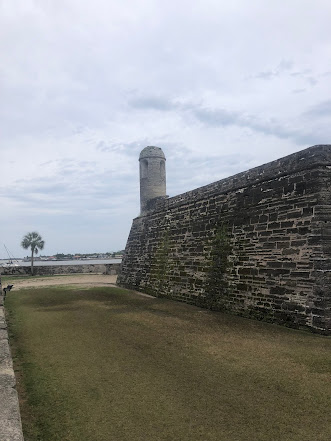St. Augustine, Florida
March 31, 2022
The Castillo de San Marcos is the oldest stone masonry fort in the United States, and is one of the most distinctive local landmarks of St. Augustine. Following the Spanish Colonial settlement of Florida, construction on the Castillo commenced in 1672 and concluded in 1696. The walls of the Castillo are made of coquina, a porous, flexible, seashell-based material that aided in the Castillo's longevity, even while being bombarded by enemy forces: thus, the Castillo was never successfully captured. However, when the ownership of Florida first shifted to Britain starting with the Treaty of Paris (1763), so too did the name of the Castillo itself, being rebranded Fort St. Mark. After Spain first regained Florida, then ceded it to the newly-created United States, the Castillo was again renamed Fort Marion, prior to its official designation as a National Monument and the reverting of its name to Castillo de San Marcos.
Official website: https://www.nps.gov/casa/index.htm
Exterior Image 1
Exterior Image 2
Artifact Image 1
This is a hot shot furnace located at the front of the Castillo, facing the inlet. The furnace was used to heat iron cannonballs up until they glowed, with the cannonballs then being carefully removed with tongs and fired from guns positioned along the seawall with the aim of setting ships on fire. Hot shot furnaces were only used for assaults, and never in full-on battle, due to the extensive time it took to prepare each cannonball. Eventually, the advent of ironclad ships during the Civil War period made hot shot furnaces obsolete, and this one was soon discontinued.
Artifact Image 2
This is the front entrance to the Castillo, accessible by drawbridge over the fortress's old moat. The moat was created to prevent attackers from scaling the walls from the outside or digging underneath the walls. With direct access to the inlet, which frequently rises and falls with the tide, the moat could be easily drained or filled. The drawbridge has gone through many iterations, from its original design as a Spanish crank-powered bridge to its British remodeling with a wooden door to the United States' own attempts to find a representation that balances the two. Unfortunately, in the early 20th century, the National Park Service's attempts to reenact the fort's original appearance, filled moat and all, caused severe cracks along the porous and centuries-old coquina foundations. Nowadays, park rangers are much more cautious when making decisions regarding the best way the present the fort.
Image in Conversation 1
Literature in Conversation
One of Lauren Oya Olamina's Earthseed verses in Parable of the Sower describes several of the traits that gave the Castillo, and more importantly the Spanish, great success in the St. Augustine colony. Lauren's verse reads, "All successful life is adaptable, opportunistic, tenacious, interconnected, and fecund." (Butler, 99). The Spanish colonists were certainly adaptable to the Florida environment, particularly when selecting coquina, a foreign substance, as the building material of choice for the Castillo. Simply leaving Spain for the promise of good fortune overseas made nearly every colonist opportunistic. Despite their town being laid to waste and set ablaze by invading British forces, the Spanish were tenacious while sheltering in the Castillo, and survived to rebuild their town back stronger than before. Through extensive colonization efforts, the Spanish created an interconnected population across their Florida territory, strengthening unity and coexistence. In turn, with a stable population in the New World, Spain was fecund enough to grow foster growth and development beyond the borders of their country. Thus, according to Lauren's own criteria, the Spanish and the Castillo were undoubtedly successful.
Creative Component
Haiku - The Seashell Stone











No comments:
Post a Comment